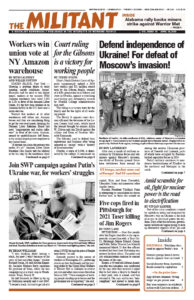SYDNEY — Flooding in southern Queensland and eastern New South Wales in late February and early March, following exceptionally heavy rain, killed at least 22 people and destroyed or damaged more than 25,000 homes and businesses in the two states. The federal and state governments left workers and farmers hit by the catastrophe to cope on their own.
In Lismore, one of the northern New South Wales towns hardest hit by flooding in early March, some residents had to wait on their roofs for days before being evacuated. There were major shortages of government rescue boats and helicopters, and private helicopter operators contracted to be on standby weren’t deployed.
Aboriginal communities hit by the flooding organized their own boats to help evacuate people and have set up their own relief center. “Seeing how everybody has just risen from the bottom up to support one another just goes to show how the systems put in place by our government are not there to serve the people for their health or well-being,” Ella Bancroft, a volunteer from the Bundjalung community, said. “And it actually just falls back on the civilians and community.”
The region was hit again by rain and floods March 30. There was chaos in Lismore as New South Wales State Emergency Service first rescinded, then reissued, an evacuation order. The river flowing through the town broke its levee, but no alert went out because the warning sirens failed. Again, workers and farmers relied on their neighbors and fellow workers for help. Volunteers from across the state have joined in cleanup operations as residents have returned to their homes and piles of flood-damaged waste piled up.
Australian Prime Minister Scott Morrison made clear that he didn’t consider it was the government’s responsibility to respond immediately. “The first response is always going to be the community response,” he argued. Then, under pressure from upcoming federal elections, he sent in units from Australia’s armed forces to assist with the cleanup.
In some flood-affected neighborhoods power wasn’t reconnected for several weeks. Electrician James Brasier told the Australian newspaper he was demanding the state government clear “red tape” obstacles to allow houses to get plugged back into the grid. Many families have no choice but to move back into their houses even if they’ve been deemed uninhabitable.
In New South Wales the majority of families and many small businesses impacted by the floods have no insurance. State governments announced that they will provide grants of up to $75,000 Australian dollars ($57,000) to these farmers and AU$50,000 to businesses. But after a month, less than 5% of requests have been approved and fewer paid out.
A number of young farmers struggling to pay mortgages have had their grant claims turned back. “These are producers that have to work off-farm to make ends meet and simply don’t have the cash flow to pay for extensive property repairs and their mortgage,” Brad Wedlock, project officer of the Mary River Catchment Coordinating Committee, told ABC Rural News.
Severe flooding in Lismore is a regular occurrence, and residents have been calling for changes to the water-catchment infrastructure for years. But working-class housing is often built on lowlands, yielding greater profits to builders. Here in Sydney new subdivisions of working-class housing are still being built on flood plains.
The working-class neighborhood of South Windsor had been hit by floods just a year ago. Residents there told the Militant they couldn’t afford the insurance fees that were hiked up after previous flooding. For families that had lost all their furniture and appliances, the government’s one-off handout of AU$1,000 was nowhere near enough.
Students rallied outside Prime Minister Morrison’s Sydney residence March 25, calling for “greater action against climate change” to control flooding. But the social devastation working people face in the wake of the floods isn’t caused by “climate change.” It is the product of capitalist rule and all the parties that defend it. It is their lack of preparedness and belated government response, coupled with disdain for working people, that turns “natural disasters” into a social crisis.
“This is the opposite of the response of the Cuban government,” Baskaran Appu, Communist League candidate for the federal senate from New South Wales, told the Militant. “In the wake of natural disasters, Cuban authorities and mass organizations mobilize to evacuate everyone who is in danger and immediately begin repair of housing and infrastructure. That’s only possible because working people in Cuba took political power out of the hands of the capitalist class and made a socialist revolution.”

